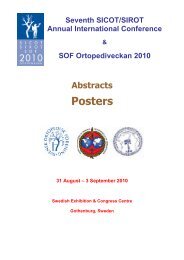Cubital tunnel syndrome due to the anconeus epitrochlearis ... - sicot
Cubital tunnel syndrome due to the anconeus epitrochlearis ... - sicot
Cubital tunnel syndrome due to the anconeus epitrochlearis ... - sicot
You also want an ePaper? Increase the reach of your titles
YUMPU automatically turns print PDFs into web optimized ePapers that Google loves.
Sicot Case-Reports: July 2002<br />
muscle present in 32 of 102 cadavers. However, Clemens [2] reported only four<br />
cases out of 100 cadavers, one of which was completely developed and o<strong>the</strong>r three<br />
having only a rudimentary muscle. Although sexes and arms may have nearly equal<br />
incidences, <strong>the</strong> anomalous <strong>anconeus</strong> <strong>epitrochlearis</strong> has been reported <strong>to</strong> be more<br />
well developed in men and in <strong>the</strong> right arm [6]. Hirasawa et al [4] reported similar<br />
findings. They reported a weight lifter with bilateral ulnar nerve neuropathy, which<br />
was caused by hypertrophy of <strong>the</strong> muscle. In our study, <strong>the</strong> patient was also<br />
muscular and enjoyed weight lifting. The boundary for potential ulnar nerve<br />
compression begins approximately 10cm proximal <strong>to</strong> <strong>the</strong> elbow and end about 5cm<br />
distal <strong>to</strong> <strong>the</strong> joint. One of <strong>the</strong>m is olecranon groove bounded anteriorly by medial<br />
epicondyle, laterally by <strong>the</strong> olecranon and ulnohumeral ligament, and medially by a<br />
fibroaponeurotic covering, which is also called cubital <strong>tunnel</strong> retinaculum (CTR). This<br />
retinaculum has exactly same course as did <strong>anconeus</strong> <strong>epitrochlearis</strong>. Thus,<br />
O'Driscoll et al [7] considered <strong>the</strong> CTR as a remnant of <strong>the</strong> <strong>anconeus</strong> <strong>epitrochlearis</strong><br />
muscle and its function is <strong>to</strong> hold ulnar nerve in position. Compression at this site can<br />
be caused by a wide variety of conditions. Aberrant <strong>anconeus</strong> <strong>epitrochlearis</strong> is one<br />
cause of lesions outside of <strong>the</strong> groove. In humans, <strong>the</strong> muscle is probably atavistic<br />
and is replaced by a band passing in <strong>the</strong> same direction as <strong>the</strong> muscle, called <strong>the</strong><br />
epitrochleo<strong>anconeus</strong> ligament. The treatment for ulnar neuropathy at elbow joint with<br />
an associated <strong>anconeus</strong> <strong>epitrochlearis</strong> muscle varied from excision of <strong>the</strong> mass <strong>to</strong><br />
anterior transposition. Vanderpool et a! [9] and Dahner LE [3] suggested local<br />
decompression and excision of <strong>the</strong> muscle. Although Chalmers [1] recommended<br />
anterior transposition of <strong>the</strong> ulnar nerve, we split <strong>the</strong> <strong>anconeus</strong> muscle and local<br />
decompression of <strong>the</strong> ulnar nerve at <strong>the</strong> cubital <strong>tunnel</strong> was carried out without<br />
anterior transposition. Subluxation has not noted after splitting of <strong>the</strong> muscle in this<br />
study. Masear et al. [6] presented improvement of electrophysiologic study between 8<br />
and 12 months after operation. We also aware of improvement of electrophysiologic<br />
study after surgical release. It is probable that <strong>the</strong> <strong>syndrome</strong> can be caused by<br />
weight lifting and o<strong>the</strong>r overuse condition. If isolated compression by <strong>the</strong> aberrant<br />
muscle, in situ decompression only can achieve satisfac<strong>to</strong>ry result.<br />
Page 3
















